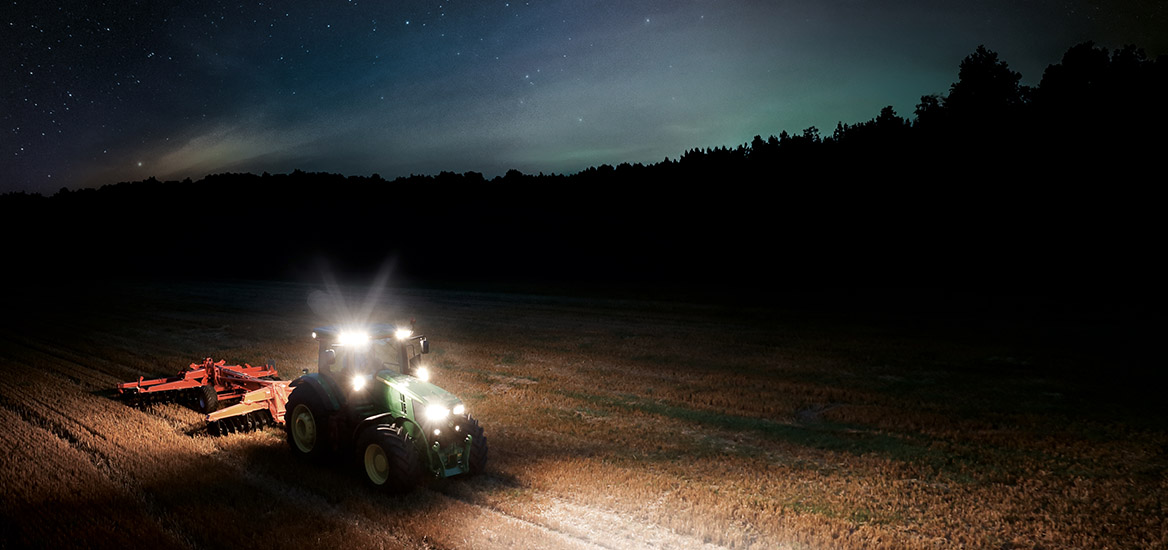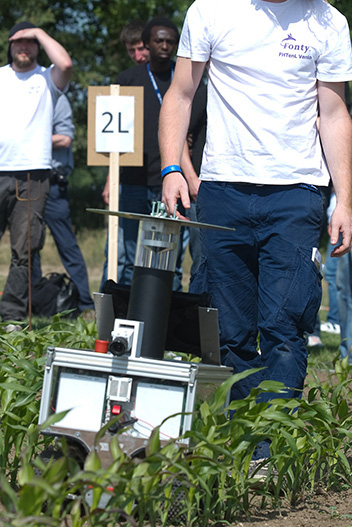
This is how farmers can find the right work lamp: 7 points to follow and to lead you to the perfect match
02/28/2020The sun has not yet come up, the fog hangs thick over the fields. Nevertheless, the harvest is waiting to be gathered – even when visibility is bad. Does all this sound familiar to you? Of course it does, it's almost an everyday occurrence for farmers! This is when the best kind of lighting is vital. What you need, purely and simply, is good work lamps. But what are the important selection criteria? Here's your guide.
1. Keeping everything in your sights! Choose the right lighting technology for work lamps used in farming
It is often the case that farmers are on the go with their vehicles and machinery when lighting conditions are anything but ideal. Therefore perfect illumination of the working area is absolutely essential to achieve high productivity. You can choose between various kinds of lighting technologies to find the ideal illumination for your purposes. For example halogen. Halogen is a tried-and-tested technology, which scores high points because its bulb can be changed so simply.
Lighting technology: LED has arrived in the world of agriculture
Today many people working with agricultural machinery are putting their money on LED lighting technology. There are quite a few good reasons for this: extremely long lifetime, minimal energy consumption, powerful light performance. And on top of all that, when they come installed in quality products of reputable manufacturers (such as HELLA ), they lend themselves fantastically to operations under tougher conditions for all the following reasons: they are dustproof and waterproof, they demonstrate good vibration behaviour and they also withstand extreme temperatures and external factors such as gravel throw. Have a look, too, at the active thermal management of LED headlamps: the work lamp is automatically dimmed before it can overheat.
LED technology: colour temperature and illumination are the decisive factors.
LED work lamps have a higher colour temperature than halogen bulbs and can therefore provide illumination close to natural daylight. Such light is less tiring to the eyes and it also improves your colour vision. You can then concentrate better and you become more productive. Because the human eye automatically focuses on the brightest point of a surface, it is important for work lamps to illuminate working areas evenly. HELLA’s lighting technicians therefore develop work lamps that reduce the light concentration at close range, where the light is otherwise extremely strong, with steadily increasing illumination into the distance. The result is that the light distribution is more homogeneous. You can test the light distribution of HELLA LED headlamps online with our Eliver tool: www.hella.com/eliver And by the way: halogen and LED lighting can be easily combined. Simply replace defective halogen work lamps with new LED work lamps – but it's always better to do that in pairs.
2. Everything spotlessly clean? Watch out for the IP protection class of agricultural work lamps
Don't forget you work out in all kinds of weather. This means that even if the work lamps are the right ones, they are subjected to quite a few hardships. The suitable IP class is a must. The IP protection categorisations state to what extent the electrical equipment of vehicles, for example work lamps, is protected against certain environmental conditions such as dust or water. In practical terms that means the following: not only do the work lamps have to be protected against rough weather conditions but it is also necessary for them to be able to withstand aggressive media and it's important that they can be easily cleaned. You should pick IP protection class IP6K9K for your agricultural machinery. This will enable you to wash them down with a high-pressure cleaner without any problems. Another important point: the good EMC compatibility of your new work lamps. Then other electronic devices will not be subjected to any interference when the lamps are in operation.
3. Making room for us! Check how much mounting room is available for the lamps on your agricultural machinery
Also when selecting lamps, it is important to consider the structural design of the vehicle: even small work lamps produce heat. So as to avoid any malfunctioning, it is important that sufficient space is available around the work lamp. At HELLA, we give line drawings for every work lamp in our product descriptions, stating precise mm details so that you can calculate and plan better.
4. Better safe than sorry: checking work lamp approval regarding the transport of dangerous goods for farming purposes
If the transporting of aggressive or potentially hazardous media is part of your daily work, then your work lamps have to fulfil special legal regulations. So for that reason, ensure that they carry the appropriate symbol: it shows a diamond with a flame inside. That means that these products are approved for mounting on means of transport or conveyances that must comply with the provisions of GGVS/ADR B Rn 10251 and Rn 11251 for electrical equipment
5. Choosing the right mounting positions for the work lamps
There is a wide variety of ways in which the lamps can be mounted. Depending on the vehicle and on your requirements, this means that not only the working area but also all around the vehicle can be illuminated. This could mean the area immediately in front of or behind the vehicle/machinery, the step or ladder area to climb aboard, the vehicle interior, the sides or the ground stretching ahead of the vehicle.
6. How flexible must your new lamp be? If you have specific requirements, look out for the available extras
If you have to often change from one working area to another and in doing so use your machinery to redirect illumination, then you should ensure that your lamps are equipped with a swivel base or with a bracket for sturdy four-point fixing. If the work lamp is to be switched on and off from outside the driver's cab, a built-in switch in the work lamp is practical.
7. Where should the focus be? Combining work lamps to achieve the perfect illumination
The question of what kind of illumination is best is complex: it is not only a matter of the required light output but also whether the mounting position should be higher or lower and which tilt angle is to be selected. All these issues are crucial for the final result. Most work lamps are available with close or long-range illumination. In order to get illumination which is optimal and homogeneous, it would be advantageous to combine these two kinds of illumination. When mounting lamps, it is also important to pay attention to the tilt angle and the lateral range of twist in the individual devices. Make sure that optimal and streak-free illumination of the work area is always achieved. We hope that this short overview has helped you to decide on the right lamp for your purposes. We will, of course, be very pleased if you decide to take a closer look at our product range.

